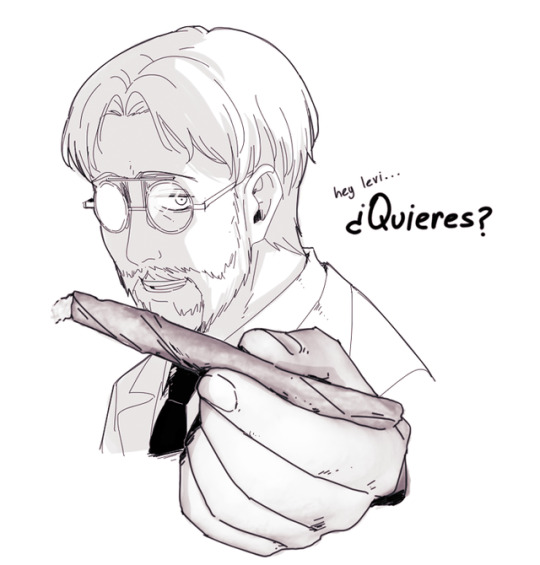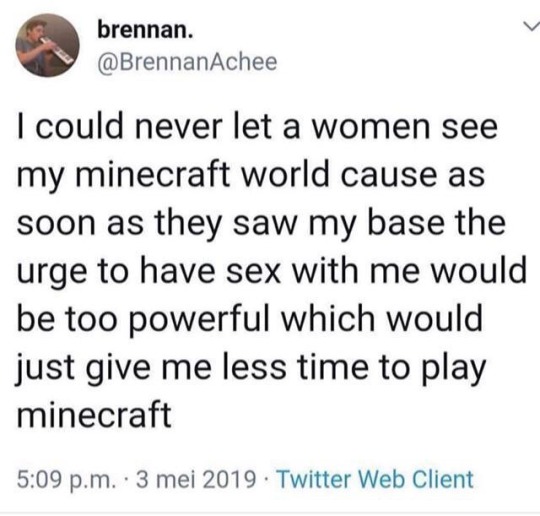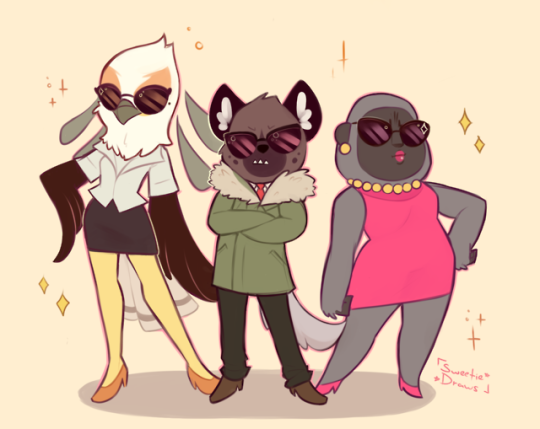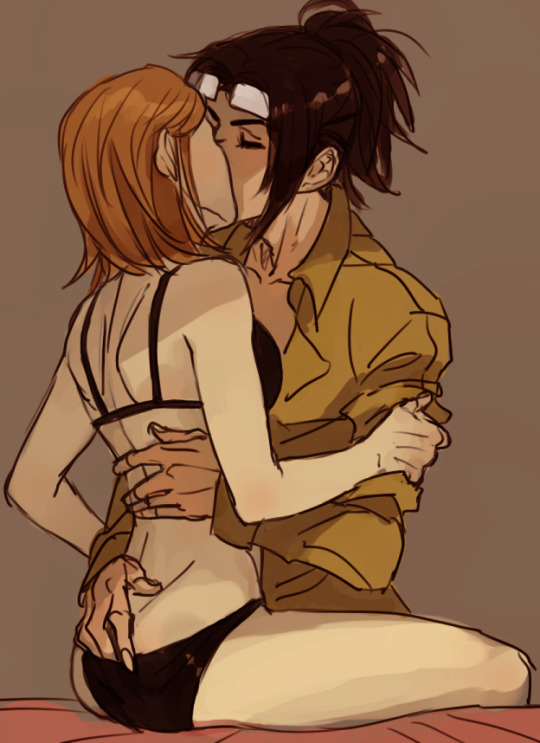Text
It looks like I was right for ones 😁
The theology of Attack on Titan

I am not a theologian, so my knowledge may be wrong and is based on books I have read so far. Please don’t blame me.
I have already written two posts on possible theological reasons for Attack on Titan. Continuing to read I found several other issues that seem interesting to me. It will certainly not be my last destination in this regard, but I like this topic too much and I wanted to introduce it anyway.
First of all, Ymir Fritz is introduced as a mythical ancestor similar to the one of the Abrahamic religions, Christianity, Judaism and Islam. Despite her design, which recalls Norse mythology, her place in the three monotheistic religions is indisputable because the ethnicity to which she refers. Eldians are an allegory of the Jews and not only under a theological point of view, as Paradis is an allegory of the State of Israel from a political point of view. King Fritz seems to be the bearer of a Zionist-like ideology, since he took a land for his own needs but with other ethnic groups present on it: this is because the Eldians - like Jews - evidently felt they could not live with other populations and the need to take refuge in a part of the world to live in peace. The power of the Giants in Marley’s vision (placed in a WWII setting is a bearer of Nazi ideology) could symbolize the great Jewish financial power of those years.
Eldians also call themselves “the people of Ymir”, as Jews define themselves as God’s people. The Eldia restoration movement is convinced that it is chosen by the forefather Ymir. In the biblical tradition the giants are called “Nephilim” and are the consequence of a carnal relationship between fallen angels (i.e. the legions of the devil) and mortal women. There is no need to specify that from a religious point of view, the carnally union between the spiritual world and the physical world is considered blasphemous and can only generate curses. Other theories see giants as historically existent people with an extraordinary strength, just as Ymir is experienced both as a spiritual and mythological being and as a historical figure. Her being the Abrahamic progenitor is based on her historical dating in the universe of Shinjeki no Kyojin, i.e. 2000 years before the events narrated and the birth of Eren (which in the series represents the messiah), exactly as the figure of Abraham is dated 2000 years before Christ.
The various depictions of Ymir see her entertain some kind of relationship with a demonic figure and her name varies in the literature from Ymir to Krista. Therefore, it is not to be excluded that the monster and Ymir had some relationship, from which the curse of the giants was generated and that, therefore, according to the biblical tradition, it was a relationship between a demon and a mortal. There is no doubt, in fact, that the giants are a curse and is confirmed by the testimonies of different characters in the series. Even Frieda is described as “possessed” in some moments, as if she suffers a demonic possession: whoever is possessed by the power of the giant lives a state of such profound desperation (which someone in theology defines as “the dark night of the soul”) that does not leave other solution but suicide.
In almost all the confessions of Christianity, original sin is the one that Adam and Eve, forefathers of humanity according to the biblical tradition, would have committed against God, as described in the book of Genesis. This is in fact the genesis of the Jewish religion and its people, such as the relationship with the demon of the earth and the sin committed by Ymir (of which the apple is a symbol in rock painting). In any case, Jews do not believe they have inherited the “guilt” from Adam, but only the consequences of his reckless choice. In the same way Eldians do not have a real fault for the sins of Ymir (even if they have decided to expiate it), but they suffer the consequences. In any case, Adam is recognized by some currents as the one who brought death into the world through his disobedience. Another issue is the concept of expiation proper of the Marley’s Eldians, who pretend to take on their shoulders the sins of their predecessors in order to extinguish them definitively. In the Jewish doctrine, unlike the Christian one, there are no sins that can not be expelled and everything can be extinguished through repentance and sacrifice. This is what Marley’s eldians do and in particular we are made clear by Gabi in her speech with Kaya. In this sense also the number 13, which are the years of life remaining to those who inherit the power of the giant: the number 13 is the number of death and rebirth and who lives under the number 13 has the possibility to conclude what is left unfinished by its predecessors.
Ymir, however, is used by the peoples according to the cause and nothing is actually known about her and her truths. It could also be considered a founder really existed, unlike Abraham which is part of the myth and not historically proven. Unfortunately nobody knows the truth and probably nobody will ever know it. I have already mentioned in a previous post that for me Attack on Titan is the story of a people passing from the Old Testament to the New Testament. This is based on the religious vision within the walls, which is much more similar to the old beliefs than to the new ones. At the beginning of the series, when the giants break through the walls, a man makes a speech about how they are deserved, because they have sinned in different ways. The concept of “bad people happen bad things and good people happen good things” is a custom, probably dating back to a pagan period, in which if a lightning struck your home was because you had sinned against the gods and were punishing you. This concept is discussed in the book of Job, in which this upright man is struck by one misfortune after another and not because he has sinned against God; rather, he is described as his most faithful servant. Representing Eren a messianic archetype, and being the protagonist and therefore the one who is destined to resolve the story, the idea is about a travel from from the ancient testament of Abraham (Ymir) to the new testament of Eren. The division of the world of Eren in black and white, as a matter of fact, is continually discussed and criticized and must learn to love his enemy and understand it, and this is the supreme teaching of Jesus Christ himself. Eren, however, is a bridge between the religious vision of Christianity of Messiah chosen by God (since it would seem that all events are controlled by Ymir or a higher spiritual force) and the atheist one of Buddhism, in which through its path will ascend how to be perfect (eliminating its narrative flows). Moreover, it would also seem to be in common with the Davidic messiah, who opposes and defeats the opponents and even the first King presents similarities with the figure of David (David fought against the giant Goliath, but he was a man like Marley’s men): the final Jewish goal is realized in a Davidic monarchy that the messianic advent should restore. The oppression of the giants settled on their land deprives the liberals of the eldians of Paradis like Roman people settled Palestine in the times of Christ. The Jewish messiah refers to a human leader, a physical descendant of the lineage of King David, who will rule and unite the people of Israel and lead him to a messianic era of global peace, and this is also what Grisha and Dina saw in Zeke. The Jewish messiah, unlike the Christian one, is not considered divine.
The departure of the Eldian people as people of the Old Testament is also underlined by the original Nine giants: as the Jews originate themselves from the twelve tribes of Israel, it seems plausible that the Eldians originated from the nine giants. The third ending, then, represents a mass exodus (where the diaspora is the symbol of the Jewish people and its sufferings) in the desert and towards a light. The desert is a place of expiation. The end of the ending shows a painting by Ymir with the Giant Nine, but there is a fracture on her face. Giants are considered chaotic beings, but the term “chaos” has not always meant disorder and originally meant fracture.
About a possible conclusion of the series, I like hazard a theory. According to some biblicists, the struggle between Gog and Magog described in Ezekiel should take place at the end of the days, where this term means an event with catastrophic consequences at the global level, such as to cause the destruction of the earth and the human species. The threat of the giants inside the walls that will devastate the world can not be left to a mere quotation, but given the cumbersome presence in the series it is highly probable that this will actually happen at the end (moreover the walls will somehow have to be turn down). Gog and Magog up to the legendary populations of Asia, cited first in the biblical tradition and then in the Koranic tradition as wild and bloody people, source of looming and terrible threat or however identifiable as negative entities. These are the two mutually contrasting factions, as Marley describes eldian people with millennia of rapes and devastation behind them and which threatens the world with the giants, while eldia from Paradis sees the Marleyans as people without hearts and bloodthirsty who unleash on the island giants without brains and really violent.
The assumptions are those for an apocalypse, in what was initially presented as a post-apocalyptic manga
50 notes
·
View notes
Text
Hello folks, it's been a while without publishing and I'd like to go back on work! I just wanna thank all of you since I see my metas are still appreciated and this means the world to me.
1 note
·
View note
Text
Her metas going deep as always!
Neo's Hecate = The Triple Goddess
Trivia is the Roman name of Hecate, Goddess of witchcraft, crossroads and ghosts. Neopolitan is Roman's Hecate, so her birth name is Trivia. Is that really all there is?

Obviously not. Or at least, Neo's allusion to Hecate can be read in multiple ways. Sure, it might have been an unplanned reference, but by this point (either willingly or not) Neopolitan has grown into Hecate's role. So, let's analyze ice-cream's girl allusion to better understand her story, with a focus on volume 9.
WHO IS HECATE?
Hecate is a Greek Goddes, who is later adopted by the Romans with the name of Trivia. Her origin is probably more ancient than Greek culture, though. In short, she is a foreign deity, who gets integrated into Greek religion. Similarly, Neopolitan is an unplanned character shoved into the narrative. However, she finds her place in the story and grows into herself.
Here are some of Hecate's most famous attributes.
Hecate is the Goddess of crossroads and magic. In particular, she is the master of darkness and the queen of ghosts to the point she is linked to nechromancy. She also rules over demons called Empusas, who are half woman and half beast (either a cow or a dog usually). They eat human blood and are linked to fire. Finally, Hecate is a psychopomp deity (like Hermes/Mercury), so she moves freely among Earth (human world), Olympus (world of the gods) and Hades (world of the deads).
Hecate is often depicted with three bodies and three heads:
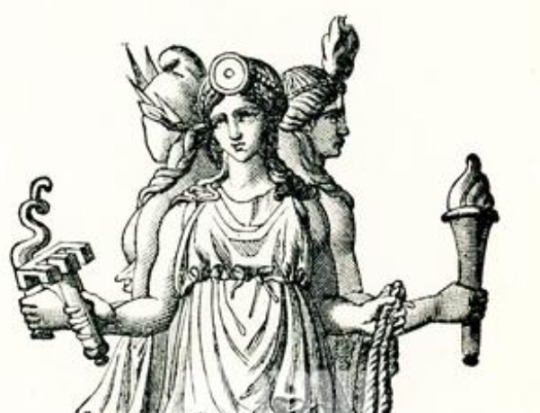
She holds torches and keys, which are symbolic of her ability to guide people in the underworld and to travel among dimensions. Sometimes, she can appear as a dog, which is her sacred animal.
Hecate is one of the Goddesses associated to the moon. In particular, she is the falling moon to Artemis's crescent moon and Selene's full moon. According to other traditions, she is a part of Artemis/Diana. This Goddess is the Moon in the Sky, Artemis on Earth and Hecate in the Underworld. Whatever the case, both Artemis and Hecate have a triple nature to them.
This triple nature makes Hecate an example of Triple Goddess in modern Neopagan religions. The Triple Goddess is the archetype of a female deity linked to the three phases of a woman's life. Youth (Maiden), Maturity (Mother) and Old Age (Crone). Her male counterpart is the Horned God.
As you see, Hecate is hard to define. Just like Neo. Both are ambiguous and difficult to grasp. Still, let's try to understand ice-cream girl better by using this mysterious Goddess. Let's focus on three things (obviously :P):
Hecate's link to the number 3 and how it is used in Neo's story
Hecate and Artemis's bond and how it mirrors Neo and Ruby's
Hecate's imagery and attributes and what they mean for Neo
The first is an analysis of Neo's interiority (microchosm). The second explains Neo's role in the story (macrochosm). The third offers a synthesis and a conclusion (balance).
RULE OF THREE (MICROCHOSM)
Hecate is known for her three heads and three bodies. Neo is a normal human, but the number 3 still comes up in her design:

Pink, white and brown. Strawberry, vanilla and chocolate. The three flavours of the Neapolitan ice cream. The three sides of Neo's self:
We are ruled by thirds. In fashion we compare no more than three colors. Our personalities are defined by the id, the ego and the super-ego- always warring vying for control. But our goal is harmony. Balance. (Roman Holiday, chapter 13)
According to Freud, the human mind is made of three parts. The id is where fear and wishes lie. It is a primitive and instinctive force. The superego is society’s expectations. It is where morality and ideals are. The ego is what balances the other two parts. It mediates between wishes and duties.
As per Roman Holiday, Neo is a combination of Neopolitan (pink), Vanille (white) and Trivia (brown). So, Neo's color scheme is a metaphorical representation of id, superego and ego:
Pink represents the id - Neopolitan is Trivia's pink imaginary friend. She embodies everything the child is forced to repress, like her pink eye and her wish for freedom.
White represents the superego - Vanille is Trivia's surname and a shade of white. The Vanilles want their daughter to fit into society and despise her disability, which makes her "odd".
Brown represents the ego - Trivia has brown hair, wears brown clothes and a brown contact lens. She is conflicted between her parents' expectations and her own wishes.
In her childhood, Trivia is unbalanced because her family forces her to repress her id. She cancels her pink side and projects it on her imaginary friend Neopolitan. So, Trivia undergoes a transformation and claims this part of herself back:
As the old saying went, “You can’t put the moon back together”. At times you had to destroy something to make something even better in its place. When Mama had shattered Neopolitan in front of their burning house, Trivia finally understood that she had been broken all along. Losing her friend was Trivia’s first step toward putting herself back together and embracing her true, best self. (Roman Holiday, chapter 11)
She re-arranges herself and her three parts:
Pink becomes the color of Neo's ego (her truest self). She stops hiding her eye and dyes half of her hair pink. Similarly, she embraces her Neopolitan persona more.
Brown becomes the color of the superego. It is a color linked to Neo's female authority figures like her mother (Carmel) and her teacher (Beatrix Browning). It is still present in Neo's color scheme, but much reduced. Similarly, Trivia is still there, but feels more like a mask than Neo's real self.
White becomes the color of the id. It is the color of Neo's family name, which she sheds. However, Neo still loves her parents, so her semblance dyes a lock of her hair white as an unconscious response to their death.
Roman Holiday is the story of Trivia Vanille's death and Neopolitan's birth:
As far as she was concerned, Trivia Vanille was buried under that mess, too. Neopolitan was the sole survivor. (Roman Holiday, chapter 26)
Neo leaves behind her parents and their strict rules to become a living manifestation of the id:
She just wanted to do whatever she wanted. And for the moment, what she wanted was to help Roman set the world on fire. (Roman Holiday, chapter 26)
Neopolitan does whatever she wants, even if it hurts others. She embraces her deepest wishes and chaotic emotions. This is the character we meet at the beginning of RWBY.
Well, Neo's arc in the series is to discard this person and to become someone new once again. After all, Neopolitan's name is linked to renewal and transformation. "Neopolitan" comes from Naples, which means "new city" (neo + polis). Naples's fantastic origin itself is a story of death and rebirth. According to the legend, this Italian city is born from a Siren, who dies for love. Her body transforms into the city and gives new life.
Similarly, Neo is a character able to be reborn countless times (neo = new + poly= many). So is Hecate, whose name may refer to the Greek number 100, as the Goddess is said to have one-hundred forms.
Our Neo/Hecate is then a multifaceted force, who goes through destruction just to embrace creation.
Neo's change in the series starts with a loss:
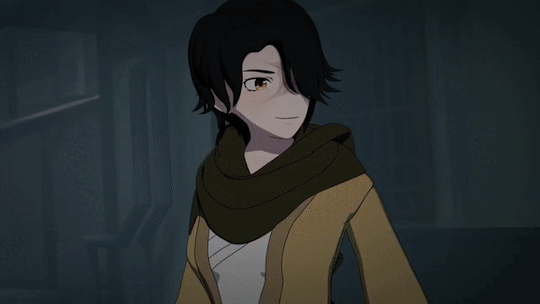
She loses both Roman and her inner balance:
There was one thing
To help escape the misery
And now it's all disarrayed
You took my whole life away
You sent me back to nothing
Now you'll pay
So, she needs to rebuild herself once again:
We must live with balance
But balance is blind
(Lost her world)
Vengeance is a riptide
In a fairy tale, she'll find
Inside
A new me, I'm ready
But who will I find?
Inside
I've gotta let go but could I lose my mind?
Volume 9 is where this inner transformation takes place. This time the new found harmony among id, superego and ego is not described by Neo's three colors. Rather, allusions are used.
In the Ever After, Neo is associated to three different Wonderland / Through the Looking Glass characters:
The Hatter, who represents the id
The Cheshire Cat, who represents the superego
The Jabberwocky, who represents the ego
THE HATTER - THE ID
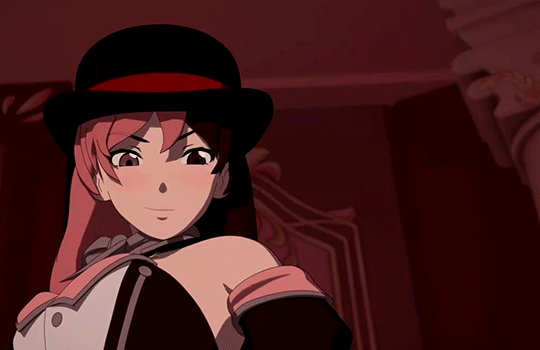
“Well, I'd hardly finished the first verse," said the Hatter, "when the Queen bawled out 'He's murdering the time! Off with his head!'"
"How dreadfully savage!" exclaimed Alice.
"and ever since that," the Hatter went on in a mournful tone, "he wo'n't do a thing I ask! It's always six o'clock now.”
The Hatter is a Wonderland and Through The Looking Glass character. He is famous for the Mad Tea Party, where he, the March Hare and the Dormouse chat with Alice. The original book reveals that the Hatter "killed time" while singing, so Time refuses to run normally for him and his friends. As a result, they are stuck in an eternal tea-party, as it is always tea-time for them. In the 1951 Disney movie, instead, he celebrates Alice's unbirthday.
Neopolitan has been stuck in time since Roman's death. She can't move on, so she focuses all her energies on revenge:
So close to closure
The one thing you need
Underneath a monument with
a dedicated plea
Killing Ruby becomes Neo's One Thing to the point she organizes a special tea party of her own:
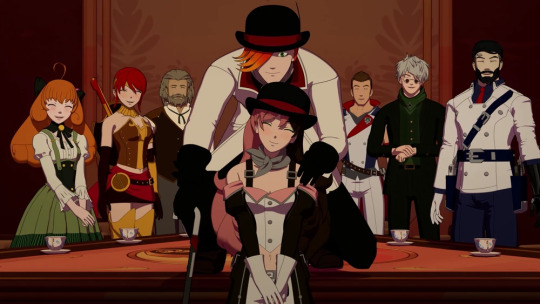
Ruby's unbirthday party, to be precise:
Cinder: And you… should have never been born…
Where she can dissolve Little Red in a cup, as if she were a sugar cube:
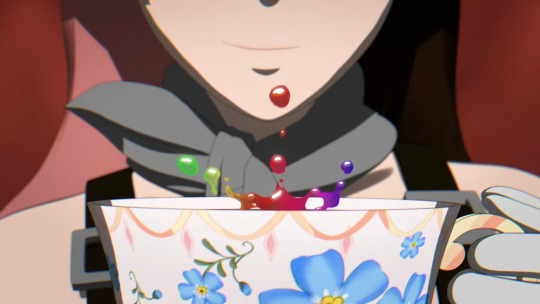
Kill for kill
Eye for eye
Blood for blood
It's time to die
Retribution tastes so sweet
The Hatter is a hostage in his tea party and Neo is a prisoner of her revenge. Both are consumed by their inability to go on. Both have killed time and can't face their future.
In Neo's case, the reason why she murders time is pretty clear. It is a coping mechanism to avoid grief:
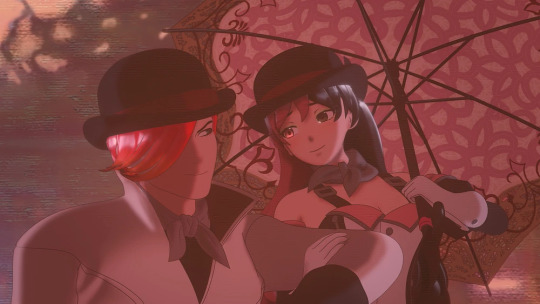
In Wonderland, the Hatter can drink tea at every hour. In her fantasy world, Neo can stay with Roman forever:
Neo-Roman: Y’know once Neo realized where she was, everything changed. Always loved the idea of a place to run away from it all. Do whatever you want. I offered that to her back on Remnant.
This is also why the first thing Neo does after landing in the Ever After is to evolve Overactive Imagination and to kill the Jabberwalker:
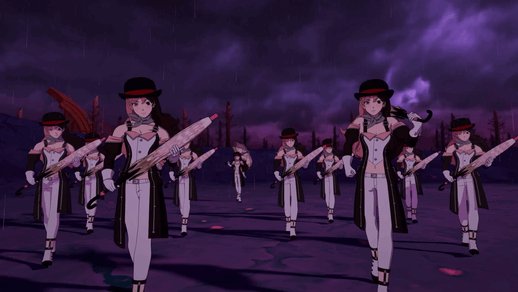
The creature is symbolic of death, as they kill Afterans permanently. So, Neo metaphorically negates her grief (the Jabberwalker) through illusions (her semblance).
At the same time, Neo enters the Ever After and gives in to her id. She has her desires and instincts control her completely. She loses all filters:
(Then suddenly)
Scratched through the surface
And you've found a key
Unlocking what you thought was safe inside a box
But it's somehow been set free
(Finally)
Overactive Imagination's evolution is a physical representation of this psychological process. Neo spirals throughout Mistral and Atlas, but in volume 9 she hits rock bottom and stops acting rationally. She becomes the incarnation of her anger, which manifests through her semblance. Her illusions are typically silent. However, in the Ever After they speak, as Neo is letting her inner voices out of the box:
Say something real
Do you only speak in riddles, chatterbox?
I'm waiting for your ugly mouth to spit it out
This is why she becomes a chatterbox. She tries to communicate through her creations.
In particular, she makes an imaginary Roman (the Hatter), who looks and sounds like the real deal. He becomes the dominant voice in Neo's mind and speaks to and for her. His presence highlights Neo's inability to accept Roman's death. She hides in a lie. Just like Trivia used to cower behind her imaginary friend Neopolitan. As a child, Trivia can't accept Neo is a part of her. As an adult, Neo can't accept Roman isn't with her anymore. In this way, Neo's first real human connection gets reduced to an imaginary friend. This is the tragedy of Neo's adventure in the Ever After.
All happens because Neo surrenders herself to the id (her inner world). Still, it can't last forever. The id is a powerful source of energy and drive, but it is also destructive. So, Neo self-consumes until she has nothing left:
Neo-Roman: (voice in Neo’s head) You’ve finally done it! Little Red’s gone. With your Semblance stronger than ever now, we can take over this whole absurd place! Why not? Offing Little Red can’t be all you wanted… Right?
She puts so much into destroying Ruby, that she ends up empty. A vessel for others to take advantage of.
Curious Cat: You’ve lost something most important, haven’t you? And now you have nothing left. How delightful! An empty host, perfect for me to fill.
THE CHESHIRE CAT - THE SUPEREGO

The Cheshire Cat appears twice in Alice's Adventures in Wonderland. The first time, he guides Alice at a crossroad and points her towards the March Hare's house. The second time, he appears at the Queen of Heart's croquet game as a giant head. The Queen and King are offended by his presence and want to behead him. Still, he is a head without a body, so the execution of this death sentence is complicated. Eventually, he simply fades away and disappears.
The character is inspired by the saying "grinning like a Cheshire Cat", whose origin is unknown. Among the many hypothesis, there is one about a grinning cat-shaped cheese. The cheese was cut from the tail, so that the last part eaten was the head of the smiling cat.
In RWBY, the character who alludes to the Cheshire Cat is not Neo, but the Curious Cat. Still, Neo and the Cat's stories are intertwined, as they destroy each other. The Cat possesses Neo and Neo kills the Cat.
Both characters eat and get eaten. They eat like the two wolves of Ruby's Little Red Riding Hood. They get eaten like the cat-shaped cheese, until only a floating head remains. A head separated from the body. A mind detached from reality:
“We’re all mad here. I’m mad. You’re mad.” “How do you know I’m mad?” said Alice. “You must be,” said the Cat, or you wouldn’t have come here.”
Neo and the Cat are mad, so they meet in the Ever After. However, their madnesses are opposite:
Neo loses herself in fantasy (the Ever After) and runs away from the real world (Remnant). She lets her unconscious feelings (id) run wild.
The Curious Cat is trapped in fantasy (the Ever After) and wants to reach the real world (Remnant). They are consumed by an imposed purpose (superego):
Curious Cat: I’m not like the other Afterans here, I’m cursed with curiosity. I need to know everything!
Blacksmith: A terrible thing to have a broken heart… And there’s nobody to send them (the Cat) back to the Tree for repair.
So, Neo and the Cat are foils, which is why they share the song Chatterbox. Both blabber non-stop. However, Neo's illusions speak her truest self. The Curious Cat instead uses smart words to hide their real intentions. Neo shows her inner beast (the shadow), while the Cat wears a mask (persona). So, Neo is the embodyment of the id and the Cat is her estranged superego. They are an external force, who comes and takes control of Neo's life:

The possession is a metaphor of Neo's state of mind. She goes from moving many characters around to becoming a controlled puppet. From shouting to radio silence. This switch is conveyed through the Curious Cat speaking through and for her.
This is Neo's nightmare, as her life is a struggle to be heard. Among other things, Neo refuses devices that make her sound robotic. She dislikes artificial voices because they sound fake to her. And yet, the Curious Cat forces Neo to speak their words. The Cat becomes Neo's new voice.
This is the result of Neo losing her inner drive:
NeoCat: She has no attachments to your world. Nothing to return to.
She is left with no wishes nor fears. She is a living id, who transforms into a walking superego. However, both extremes are wrong. A person is made of both her id and her superego. Both parts are needed to make an individual, which is why Neo is asked to face herself once more:

The Tree has the girl confront the pain and grief she has been ignoring. And yet, these feelings are what saves her:
NeoCat: No! These cracks, these feelings! I can’t… I can’t!!!
Thanks to them Neo gets back in control of her life. Symbolically, the Jabberwalker she kills in the beginning appears to finish the Cat off:

In this way, the cycle is complete and Neo's ego can finally surface.
JABBERWOCKY - THE EGO
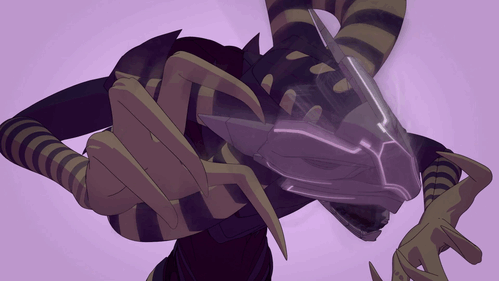
Beware the Jabberwock, my son!
The jaws that bite, the claws that catch!
The Jabberwocky is a nonsense poem Alice finds in Through The Looking Glass. She initially can't read it, but then she realizes the verses are written in mirror-writing. She holds a mirror to the text and the poem appears. Despite being able to read it, though, Alice can't understand it:
"It seems very pretty," she said when she had finished it, "but it's rather hard to understand!" (You see she didn't like to confess, even to herself, that she couldn't make it out at all.) "Somehow it seems to fill my head with ideas—only I don't exactly know what they are! However, somebody killed something: that's clear, at any rate."
The poem conveys two main ideas:
It tells about a slaughter:
He took his vorpal sword in hand:
Long time the manxome foe he sought—
So rested he by the Tumtum tree,
And stood awhile in thought.
And as in uffish thought he stood,
The Jabberwock, with eyes of flame,
Came whiffling through the tulgey wood,
And burbled as it came!
One, two! One, two! And through and through
The vorpal blade went snicker-snack!
He left it dead, and with its head
He went galumphing back.
It is impossible to understand, as it is full of gibberish and invented words
This is true for RWBY's Jabberwalker, as well:
They embody death, as Afterans killed by this creature are negated ascension
They jabber as they walk, which is why they fail to communicate with others
How does this relate to Neo? She kills the Jabberwalker, but assimilates them in her illusions. This happens because the creature is Neo's mirror. They reflect our Hecate in the making.
The Jabberwalker is a monster of grief who dies unheard:
Jabberwalker: Stop… It… Cease! No! NO! NOOOOOO!
Neo is a villain whose grief stays unrecognized:
Ruby: If you’re looking for an apology, you’ve wasted your time!
Not only by others, but by Neo too. She kills a part of herself in the Jabberwalker. Her most vulnerable and real part, that wants to communicate:
Say something real
Do you only speak in riddles, chatterbox?
I'm waiting for your ugly mouth to
Say something real
Do you only speak in riddles, chatterbox?
I'm waiting on your ugly mouth to spit it out
She is a chatterbox that screams, but is not listened to. She can't talk, then she gains the ability to speak through her semblance. And yet, she can only be heard. Never understood. Similarly, Alice eventually learns how to read the Jabberwocky poem, but doesn't comprehend it.
This is why the Chatterbox song is so mysterious. Is it about Neo? The Cat? Both? Who sings what? Are they singing to each other? Or is it Ruby singing to them? It is impossible to say, just like it is impossible to grasp the full meaning of the Jabberwocky.
So, this song is about Neo and the Cat, but plays while RWBYJ fight the Jabberwalker. That is because the monster represents Neo's frammented self. They are the girl's ego, which is so broken and confused she herself negates it. Her journey in the Ever After, though, helps Neo find inner clarity:
(Waiting for it
Sugar-coated
All you need is here
Come and find what
Redefines you
Make it crystal clear)
By the end she sees herself crystal clear:
Neo-Roman: To have what they have. What a thing, huh?
Her true wish is the same as ever. She wants a real connection. To succeed she has to let go of an imaginary one:
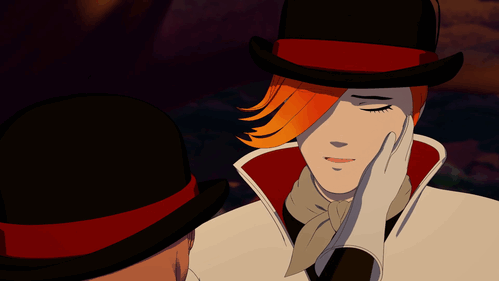
As a child, Trivia lets go of Neopolitan and finds Roman. As an adult, she lets go of Roman to find someone else. Trivia dies and Neo is born. Neo dies and someone new is born:
Blacksmith: She will have the chance to return her broken heart… And becomes something new. Such is balance.
Life from death. Creation from destruction. This is what transformation is. Symbolically, Neo kills all her three parts. She murders the Jabberwalker (ego), she rips the Curious Cat to shreds (superego) and finally releases Roman's illusion (id). Now, she is ready to move on.
HECATE AND ARTEMIS = SHADOW AND LIGHT (MACROCHOSM)

Hecate/Trivia and Artemis/Diana are two intertwined Goddesses. In particular, Hecate is sometimes described as a part of Artemis's triple identity. This Goddess is:
The Moon in the Sky (The Crescent Moon to be precise)
Artemis/Diana on Earth (Goddess of hunt)
Hecate/Trivia in the Underworld
Doesn't it remind you of anyone?

Ruby is
Associated with the Crescent Moon (Crescent Rose)
The best Huntress of all
A Red Grim Reaper with a Scythe
She is the Artemis (Crescent Moon) to Neo's Hecate (Falling Moon). This is why Neo's role in volume 9 is to play Ruby's Jungian Shadow:
In analytical psychology, the shadow is an unconscious aspect of the personality that does not correspond with the ego ideal, leading the ego to resist and project the shadow. In short, the shadow is the self's emotional blind spot, projected as archetypes.
The shadow is everything that is repressed or hidden. In Ruby's case that is her emotions over loss and grief. So, Neo becomes what links Ruby to these feelings of death. Just like Hecate/Trivia is the part of Artemis/Diana, who appears in the Underworld. This is why Neo and Ruby fall together in the Ever After.
During their fall, Neo transforms in three people Ruby cherishes: Oscar, Yang and Penny. What do they represent?
They are linked to future, present and past. In particular, Oscar is waiting for Ruby outside (future), Yang is in the Ever After with Ruby (present) and Penny is lost (past).
They are the three people Ruby's conflict is focused on in the Atlas Arc. In volume 7, Ruby disagrees with Oscar on telling Ironwood. In volume 8, Ruby and Yang fight over what to do. In volume 9, Ruby must overcome Penny's death.
These two meanings are linked to two roles Neo fulfills towards Ruby. That of Triple Goddess and that of Goddess of crossroads.
1- The idea of past, present and future ties into Hecate being a Triple Goddess:

The fates are a representation of this Goddess and a declination of the Three Hecate Sisters, also known as Maiden, Mother and Crone. They are archetypes linked to three different phases of life. Youth, maturity and old age. In other words, past, present and future.
As Ruby's Hecate, Neo often brings up past, present and future throughout volume 9. Here is a quick list:
Ruby and Neo's fall in the Ever After (Penny is past, Yang is present and Oscar is future)
Ruby's first meeting with the Blacksmith, which is followed by the appearance of Neo's Jabberwalkers. There Ruby sees three weapons. Penny's sword is Ruby's inner child (past). Alyx's knife is the role Ruby is currently trying to fulfill (present). Summer's axe is who Ruby wishes to become (future)
Ruby's fight with Neo's Jabberwalker, where Ruby hallucinates three people. Cinder is the foe Ruby lost to (past). Penny is her current inner demon (present). Salem is the villain Ruby must eventually face (future)
Neo's crazy tea party, where Neo destroys Ruby by using three loved ones. Penny is a dead friend (past), Oscar is a friend Ruby could kill (future) and Little is a friend that dies (present)
Past, present and future haunt Ruby, so that she can accept who she was, understand who she is and move towards who she will be:
Past Ruby: So, are you a Huntress? Like the ones you read about in books?
Ruby: I… I don’t know…
Past Ruby: They always saved the day, didn’t they? Always knew what to do. Always won in the end.
Ruby: But… life isn’t like a fairy tale…
Past Ruby: That’s right! It’s up to you to make things better, isn’t it? Everything all depends on you! Your sister needs you, your friends need you, the whole world needs you to keep fighting, forever and ever, against an invincible monster that took your mother!
Past Ruby: Mom was the best… but even she failed. That doesn’t seem fair. None of this seems fair.
Ruby: But… What am I supposed to do…?
Past Ruby: You can do whatever you want. Be whoever you want! You don’t even have to be Ruby Rose… So, what are you gonna be?
2- Neo brings to the surface Ruby's inner conflicts. She starts with the three struggles Ruby faces in Atlas and she keeps going by using her Jabberwalkers to re-create Atlas's destruction twice:

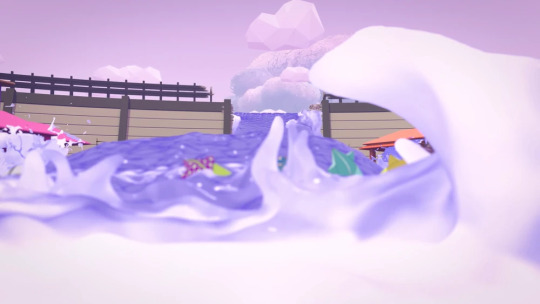
Finally, she has Ruby fight her inner demons all at once:
Neo-Ironwood: Who were you to think you knew what was best for Atlas?
Neo-Pyrrha: I was the best and brightest Beacon had to offer. But I traded my life so my friends could live!
Neo-Penny: Just like you were too late to save me at the Vytal Festival… I died in Atlas too, didn’t I? (walks towards Ruby) Can you imagine what that's like? To be completely and utterly failed… time and again… (kneels down to Ruby) by someone who meant the world to you…
Neo-Pyrrha: How many more people are going to die because of you?!
Ruby: I’m trying to save everyone!
Neo-Ironwood: And yet with all your best intentions… Have you ever stopped to wonder if you’d done more harm than good?!
Ruby: It’s not my fault…!
Neo-Ozpin: How many more lives do you have to ruin before you realize you’re not cut out to save anyone?!
Ruby: NO!!!
This happens because Neo is a manifestation of Ruby's id. Just like Hecate is a Goddess linked with crossroads and choice, Neo forces Ruby to transform.
Ruby's hidden self and her conflictual feelings are intertwined in Neo, who is the part of herself Ruby refuses to aknowledge until it explodes.
Let's juxtapose these two scenes:
Ruby: What is this about? The White Fang? Roman Torchwick?
Ruby: Is that seriously what this is all about? You still blame me for what happened to Torchwick?!
In volume 4, Ruby asks Tyrian why he is after her and mentions Torchwick. In volume 9, Ruby is surprised Roman's partner wants to avenge him. This happens because throughout Mistral and Atlas, Ruby starts shouldering too much responsibilities by herself. Her whole ego becomes intertwined with the duty to stop Salem. By doing so, she neglects other parts of the self:
Maria: You know, you don't give yourself enough credit.
Ruby: Oh… Thanks.
Maria: That wasn't a compliment.
Which leads to the shadow suffering and festering. Inside Ruby, the shadow is her grief and trauma. Outside, the shadow is Neo. A secondary villain with a revenge agenda, which is nothing compared to the threath Salem represents. And yet, Neo's personal grudge grows until she becomes dangerous for Ruby's own existence:
Neo-Roman: You don’t deserve to die, Red. You deserve to be broken down… Torn apart… wiped from existence.
In this context, Ruby refusing to empathize with Neo is really Ruby refusing to empathize with herself:
Give me anything
But this symphony of technicolor rage
You call it righteous, meaningful
It's anything but love
Don't take me for a fool
I know this all too well so
Leave your tears to someone else cuz
It's not just you who lost it all
Neo kills the Jabberwalker because she doesn't want to accept Roman's loss. Ruby doesn't see Neo because it would mean to look at her own pain.
The end result is bad for both girls. On the one hand Ruby is overwhelmed by trauma and chooses to disappear. On the other hand Neo realizes how empty she is after Ruby is gone. That is because shadow and light can't live without each other. They need to integrate, which is what Ruby and Neo do by the end.
Both see themselves more clearly, so they are finally able to empathize with each other:


Their conflict almost kills them, but once they get throught it they are ready to become better versions of themselves. They die and are reborn:

Since she had used her Semblance for the first time to create a butterfly with one pink wing, one brown, with white spots all over- then sent it out her bedroom window and watched it flutter away until she lost sight of it and let it go. (Roman Holiday, chapter 11)
Like two butterflies, who step into a brand new phase of their lives.
HECATE (BALANCE)
Neo's story is about finding balance inside and outside:
Inside- As a child, Neo is too repressed (superego), so as an adult she becomes uncontrolled (id). Her arc has her grow more balanced (ego).
Outside - In volume 9, Neo is Ruby's shadow (id) and brings out all of Ruby's negative emotions. By the end, though, Ruby is able to understand Neo and feels sympathy for her. This is because our LRRH doesn't refuse her own shadow anymore.
In other words, Neo is an id character, who has to integrate both with herself and with the world around her. This fits Hecate, who is a Goddess linked to the Underworld. The Ever After itself is a representation of this kingdom for three different reasons:
It is the world before (under) Remnant
It is the world of the deads (buried under)
It is the world of the unconscious (buried inside)
This is why Neo's semblance grows more powerful while there. Hecate is the queen of ghosts and Neo grows powerful enough to rule the Ever After with her materialized spirits (illusions). On a deeper level, our lady of the deads must face her own grief. So, like other characters, Neo goes through the stages of grief. In particular, Neo's stages are represented by her reactions to different characters:
The Jabberwalker she kills (negation)
Ruby she stalks and tortures (rage)
The Roman she materializes (bargaining)
The Curious Cat she is controlled by (depression)
All these meetings are a part of her journey to find both acceptance and herself. Maybe this is why throughout volume 9 she progressively becomes more and more Hecate-like. As a matter of fact, she aquires many attributes of the mysterious Goddess.
She gains her personal Empusas:

The Empusas are Hecate's demons, who look like girls with some odd body parts. In this case, Neo's heterocromia.
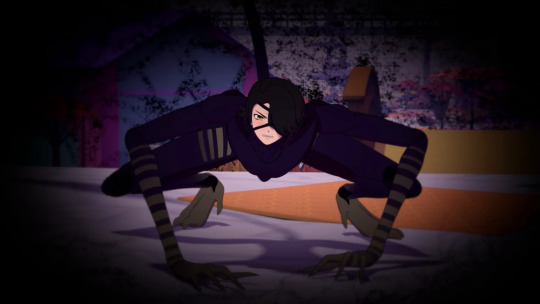
The Empusas are usually monsters linked to fire that appear as half-dogs. Here, Ruby sees the Jabberwalker with Cinder's head.
She finds her own Horned God:

The Horned God is the Triple Goddess's companion in neopagan religions. The Jabberwalker is a horned creature associated with Neo.
She commands a pack of dogs (the Jabberwalkers) and she herself plays the part of Ruby's dangerous wolf. This fits with Hecate's sacred animals being dogs.
Finally, she stands beside a wicked torch:
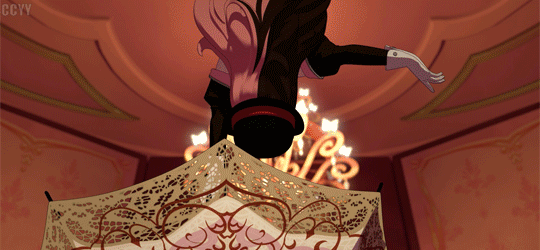
Torchwick-illusion is her companion in the Underworld and a symbol of her friend's lost soul. She even uses Roman's voice to lead Ruby towards death. Just like Hecate holds torches to guide mortals in the Kingdom of the Deads.
Despite all this, there is still an attribute missing: keys. They represent Hecate's ability to travel through worlds. However, Neo is stuck in the Ever After:
Jaune: So Neo can’t go through the door…
This happens because she has still to fully bloom into Hecate (herself). However, she is making progress and by the end of volume 9 she reaches acceptance. A necessary step to grow.
In particular, she dispels her illusion of Roman. She overcomes her grief by overcoming her own fantasies. This is interesting because it is the opposite of what happens in Roman Holiday:
“He caught a lock of her hair and showed it to her. It was white. “This is new. It suits you,” he said. Why would she have done that with her Semblance?” (Roman Holiday, chapter 26)
There, she represses her sadness over her parents' death, which manifests in her illusory white lock of hair. In the series, though, she lets go of an illusion to move on. Why is that so? That is because Neo herself is a combination of illusion and reality:
“Roman shook his head. “Show them who you really are.”
Neo changed back into herself, but swapper her school uniform for her favourite suite. Roman handed her her parasol.
(Roman Holiday, chapter 22)
Roman Holiday is the story of how she realizes illusions are a part of who she is. Volume 9 is where she learns she can't live in a world made only of illusions. So, she chooses to face herself for real:
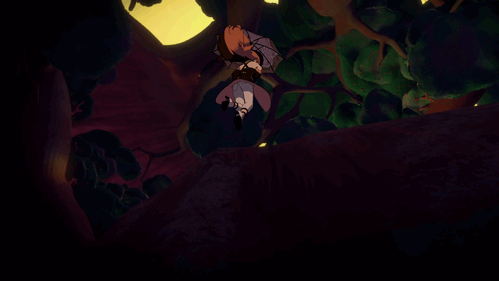
Once she emerges from the Tree, she will gain her allusion's ability to move freely between dimensions (psychopomp) and will go through the door. She will leave her fantastical world (the Ever After) and come back to reality (Remnant).
209 notes
·
View notes
Text

by maria_ra.m
art republished with artist’s permission
304 notes
·
View notes
Text
Amazing analysis of this videogame I wanna share withy followers
“And here I thought my family is fucked up” - The theme of family in God of War (2018)

In God of War (2018) family and the bonds between family members is strong theme, that the game centers around. This theme is inspected trough its main story, by side quests and character moments here and there, as the main group travels. If this still left any doubt in the players mind, the themes presence is confirmed by the games director Cory Barlog. According to him, Kratos and Atreus witness all sorts of models on how to approach family matters. Some of them are good and some of them are not that great. With these things in mind I`d like to inspect the theme of family within God of War.
I think the best way to approach this topic is compare the relationship that Kratos and Atreus have, to some other family dynamics that are present in the game. There are two big examples within the main story that show a family dynamic that does not work properly, or show a future where Kratos`s and Atreus`s relationship could spiral, if the father and son would fail. One of the examples are the Magni and Modi, the sons of Thor, and the other is the fractured relationship between Freya and Baldur.
A reflection of our father - Thor and his sons Magni and Modi

Thor is mostly spoken about during the game, and you only see his appearance from statues and the secret ending. However the stories that are told about Thor shed some light on his personality, and to the relationship he has with his sons. Thor is described as a horrible, vicious person, slaughtering the Jötanar (giants) with Mjölnir when he crosses paths with them. Thor`s cruelty and bloodlust can also be witnessed by the player, as Kratos and Atreus see the corpse of the giant stone mason, who Thor murdered. Magni`s and Modi`s relationship with Thor appears to be a difficult one. As you eavesdrop the conversation between Mimir, Magni, Modi and Baldur, it seems that they are living in their father`s shadow, trying to impress him. This likely indicates that Magni and Modi either want to be like their father, or at least to be respected as much as him. Their desire to impress their father might also be connected to how Thor responds to failure. As you are retrieving the magic chisel, you can yet again hear pieces of conversation from Magni and Modi.
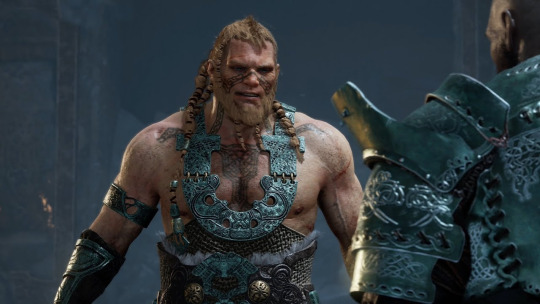
They say that they must not disappoint father. There is a small feeling of dread in their voices as they say this. The reason for this is revealed, after Atreus, Kratos and Mimir meet the beaten up Modi after Magni`s death. Modi is in a really bad shape, he has been beaten up to the point where it is difficult to walk and stand. Thor blames Modi for the fate of Magni, even going as far as calling him a coward. To drive this lesson home and as punishment, Thor has beaten his son.

The sons of Thor want to be powerful and impress their father. This is likely because Thor`s violent and strict response to failure, and Magni`s and Modi`s wish to be powerful like their father. Essentially one could craft and interpretation, that the brothers have come to resemble their father. While their tale is tragic, their conduct and behavior is cruel and vicious. Thor with his behavior has essentially passed on his cruelty to his sons. They are like him. This is interesting because Kratos wishes to do the opposite with Atreus. While his teaching at the beginning might be a bit strict, he does not want his son to be like him in certain elements. More than that, he wants Atreus to be better than him.
Continua a leggere
53 notes
·
View notes
Note
Hey i know you posted it two years ago but i just read through your analysis on the dynamic between punpun and Aiko. I recently finished reading Goodnight punpun. After reading the first six volumes i stopped for a long time before binging the rest of the books in one sitting. It completely ruined my day and affected me in a way few works of fiction ever have. Reading through your text kinda helped me make sense of that whole experience, and for that i thank you.
Awwwww! ❤️ Thanks a lot!! It's my favorite manga ever and I am so glad you appreciated my analisys 😍
10 notes
·
View notes
Text
The story of Hollow Knight

Hollow Knight is a Metroidvania style videogame developed and published by Team Cherry. It introduces a very interesting lore, telling the story of a Knight without a past on a quest to save the abandoned insect kingdom of Hallownest.
In this meta I want to analyze the lore of the entire game, which is very interesting and addictive. Obviously this article is full of spoilers for those who have not yet played the game. Also this analysis is based a lot on what I found written in the Hollow Knight wiki, even if I had some personal reflection.
In the Kingdom of Hallownest there are many different important primordial higher beings, god-like bugs who have lived since the beginning of time, and others who are more recent but who are nevertheless divinized by the inhabitants of the Kingdom. However, for a better analysis we must first introduce a summary of the Hallownest’s history in game.
The Hollow Knight (the one who gives the title to the videogame) is a Vessel chosen by the Pale King to seal away the Radiance and save Hallownest from the Infection. As wiki says, they were the child of the King and the Queen of Hallownest, birthed in the Abyss to be infused with the power of the Void. Because of that we consider them genderless and their birth condition was also supposed to leave them without a mind, will and voice. Thanks to this particular condition, void creatures are the only ones that can contain the Radiance, since the Radiance feed themselves with the light of dreams also distorting them as if they were physical entities. However purity of the Hollow Knight was misjudged because they created an emotional bond with the Pale King who raised them.
“Regardless of their impurity, the Hollow Knight was trained and raised, eventually becoming a fully grown Vessel. The Radiance was sealed within them, and they were chained within the Temple of the Black Egg where they were expected to contain the Infection for eternity. However, because of the aforementioned impurities, the Radiance could still exert influence. It ultimately resulted in the resurgence of the Infection and the Kingdom falling into ruin. Over time, the Hollow Knight disappeared from the fallen Kingdom’s memory. Only the Memorial in the middle of the City of Tears testifies of their sacrifice to save Hallownest. After some time, the Radiance’s power broke out of the Hollow Knight, cracking their shell and fully infecting them. This event was the catalyst that brought the Knight back to Hallownest. The Knight can free and fight the Hollow Knight after killing the three Dreamers who sealed the Black Egg’s entrance” .
The fate of the Hollow Knight is linked to the end of the game chosen by players, because there are different finals:
- by killing the Hollow Knight the Knight takes their place in sealing the Radiance;
- by entering their mind with the help of Hornet the Knight can chase away the Radiance;
- by defeating Absolute Radiance at the peak of the Pantheon of Hallownest the Infection vanishes forever and the Hollow Knight can then be seen walking out of the Black Egg’s temple, freed from the Infection.
Now let’s move on ti analyze the main divinities in the game’s lore.
The Radiance:

“The light. Forgotten. The plague, the infection, the madness that haunts the corpses of Hallownest… the light that screams out from the eyes if this dead Kingdom. What is the source? I suppose mere mortals like myself will never understand”.
The Radiance is a secret final boss and the Absolute Radiance is her final form. She’s one of the higher being god-like bugs above mentioned, opposed to the Void, her ancient enemy. She gave birth to the Moth tribe and because of that they revered her. Unlike the individualist society of Hallownest the Radiance offered unity to bugs at the cost of a mind incapable of thought.
“After the Pale King arrived in Hollownest and expanded the minds of his new subjects, the Moth Tribe turned their backs in the Radiance and worshipped him instead. In doing so, the Radiance was almost entirely forgotten, Yet traces of her memory remained, such as a statue on Hollownest’s Crown. Her memory started spreading throughout the Kingdom, by then in its golden age. Soon, all of Hallownest began to dream of her, appearing to them as a blazing light. These dreams could break the minds of bugs and eventually enslave their wills to hers. But the King and his subjects resisted her memory, which started to manifest as the Infection. The Pale King attempted to stop the Infection by sealing the Radiance within a Vessl. These creatures, infused with the Void to be without a mind and a will, were to be able to withstand the Radiance’s influence. The Hollow Knight was chosen, raised and grown for that purpose. The Radiance was sealed within them, and the Vessel chained within the Temple of the Black Egg. However, the Pale King failed to realise the Vessel’s impurities of mind. Because of this, the Radiance was still able to invade the dreams of bugs. She ultimately wiped out the Kingdom of its inhabitants, whose King had vanished, but left the rest of the land untouched.
Time passed, Hallownest turned into a myth while the Radiance remained sealed. Her influence finally started to break out of the Hollow Knight. She regnited the full power of the Infection, threatening again the land of Hallownest and prompting the Knight to return to Hallownest”.
I found the use of light as a villain very interesting. In fictions light usually wins over darkness as god wins over evil, but in the Kingdom of Hallownest she’s the real enemy, since, in real life, the bugs follow the light blindly. However I’d like to introduce a theory now.
We can consider the Kingdom of Hallownest as built on three levels:
- the higher level is the outside world on the surface and from which the light comes through: this maybe recalls heaven, but as we said for the bugs is more comparable to hell. The vision of something which comes from a otherwordly dimension can drive everyone crazy;
- the middle level is the realm, with its inhabitants;
- the lower level is the Abyss: in fictions the Abyss usually recalls hell but that’s not totally true for Hollow Knight because of different reasons:
i) we can find the corpse of the Vessel used and thrown away by the Pale King, but it’s also the place that gave birth to our heroe, so it cannot be considered totally negative;
ii) the game tells us that the Kingdom of Hallownest is a tribute to all what bugs have been in life and this fills with a different meaning this place;
iii) we can find the Void into the Abyss and thanks to them we can defeat the Radiance forever.
So, in other words, in Hollow Knight’s lore the meaning of heaven and hell is reversed.
If we consider this theory true, we can finally appreciate why Radiance chooses to punish Moth tribe: another recurring theme in the narrative is the God who punishes men who turn their backs. Moth tribe chose the Pale King because he promised wellness, an earthly value, forever. This is clearly a sin and the tribe deserves to be punished.
The Void:

The Void is the substance of The Abyss, most of them is found in a sea at the bottom of the Abyss, but multiple beings exist who consist of Void themselves. The Void is “the power opposed”: it has the ability to oppose the light based Radiance and Pale King, who are both describes as light. When the Knight acquires the Void Heart and learns about their past the Void is unified under their will.
Since the Void completely leaks any kind of emotion and the hope It is capable of containing the Radiance, who feeds herself with dreams as if they were physical entities. Its nature of nothingness allows it to be filled with something and that’s why having been raised by the King made the Hollow Knight feel love and become imperfect.
The Pale King and his Queen:
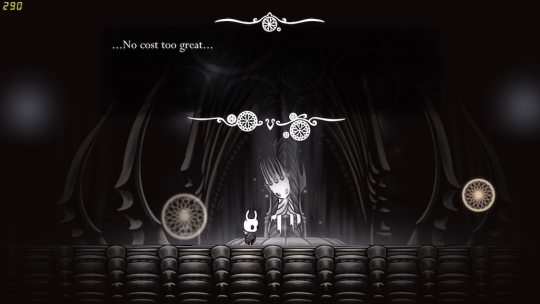
“The old king of Hallownest… he must have been desperate to save his crumbling little world. The sacrifices he imposed on other… all for nothing”.
The Pale King is considered to be a higher being who used to be the monarch of Hallownest, mate of the White Lady and ruler of the White Palace. We find him dead on his throne in the White Palace. I am sure he died of despair for not being able to find the bathroom in that absurd place he called home and whoever has played that level will agree with me. I mean, the architect should be sued.
As wiki says, he’s an ancient Wyrm who wandered through mountains and across the wasteland until finally stopping by Kingdom’s Edge. Once there, the Wyrm shed the skin and transformed himself into the Pale King. He reduced his form in order to match the bugs of Hallownest.
Contrary to what is commonly said, I don’t’ think he is a higher being for real. I think he was a mortal bug like all the others, but remaining mostly closed in his Palace he was deified by his subjects. As a matter of fact, while the Radiance has never stopped giving her people the light she promised, the Pale King has not kept his promises and if he really was a divinity he would not have died. He symbolizes the earthly power and the aura of divine that hovers around monarchical figures, who do not mix themselves with their subjects, they often make promises that they cannot keep remaining enclosed in sumptuous palaces.
Moreover, the children whom the Pale King and the Queen gave birth to are just vessels, which are mortal remains and not divine spirit: it’s the difference between the mortal body of Jesus Christ (given to him by his mortal mother) and his immortal spirit (given to him by the divine father). In the same way, the Knight possesses the mortal remains of their parents but infused with the spirit of emptiness that characterized their divine nature.
Anyway, the Pale King gives to his people free will, while the Radiance claims intellectual slavery.
The Knight:
“An enigmatic wanderer who descends into Hallownest carrying only a broken nail to fend off foes” – official manual.
The Knight is the protagonist of the videogame. A discarded Vessel, child of the Pale King and the White Lady, born in the Abyss with Void inside their shell. Like the rest of their Vessel siblings is genderless. They embody emptiness: they are not created by anyone except by emptiness itself. They are a messianic figure who bring peace to the Kingdom.
Nightmare King Grimm:
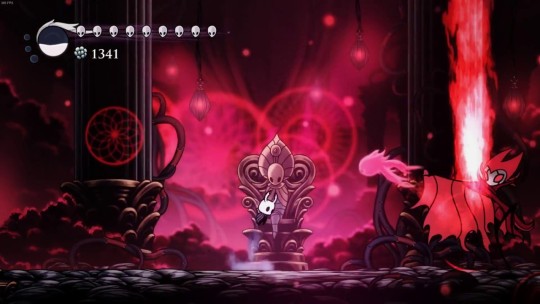
“The expanse of dream in past was split,
One realm now must stay apart,
Darkest reaches, beatin red,
Terror of sleep. The Nightmare’s Heart”.
Nightmare King Grimm is the Dream form of Tropue Master Grimm: “Through dream I travel, at lantern’s call to consume the flames of a kingdom’s fall”. As wiki says, The Grimm Tropue is a mysterious travelling circus from the Nightmare realm to wherever the Nightmare Lantern has been lit by acolytes. They gather Nightmare Flames from ruined lands to fuel the sinister being enslaving the Troupe, the Nightmare’s Heart. The Nightmare is the dimension where the Nightmare’s Heart rests. The Nightmare’s Heart is the proper host of the Nightmare, as the Radiance is the host of the Dream. The Nightmare’s Heart is a higher being responsible for the Ritual of the Grimm Troupe, Grimmchild and Troupe Master Grimm are its spawn.
44 notes
·
View notes
Photo

postcard pic for comic cup 13 at this weekend. Mike is killing me…
7K notes
·
View notes









